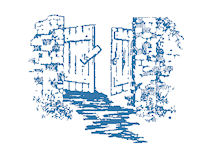John Ruskin (1819-1900), the most
eloquent of English prose writers, was much interested
in the question of literature for both grown-ups and
children. He edited a reissue of Taylor's translation
of Grimms' Popular Stories, issued "Dame Wiggins
of Lee and Her Seven Wonderful Cats" (see No. 143), and
wrote that masterpiece among modern stories for
children, The King of the Golden River. Its fine
idealism, splendidly imagined structure, wonderful
word-paintings, and perfect English all combine to
justify the high place assigned to it. Ruskin wrote the
story in 1841, at a "couple of sittings," though it was
not published until ten years later. Speaking of it
later in life, he said that it "was written to amuse a
little girl; and being a fairly good imitation of Grimm
and Dickens, mixed with a little true Alpine feeling of
my own, it has been rightly pleasing to nice children,
and good for them. But it is totally valueless, for all
that. I can no more write a story than compose a
picture." The final statement may be taken for what it
is worth, written as it was at a time of
disillusionment. The first part of Ruskin's analysis is
certainly true and has been thus expanded by his
biographer, Sir E. T. Cook: "The grotesque and the
German setting of the tale were taken from Grimm; from
Dickens it took its tone of pervading kindliness and
geniality. The Alpine ecstasy and the eager pressing
of the moral were Ruskin's own; and so also is the
style, delicately poised between poetry and comedy."
The following tale [Dame Wiggins of Lee] was
edited (1885) for children by John Ruskin from a
version "written principally by a lady of ninety (Mrs.
Sharp)". Ruskin himself added the third, fourth,
eighth, and ninth stanzas, because "in the old books no
account is given of what the cats learned when they
went to school, and I thought my younger readers might
be glad of some notice of such particulars." But he
thought his rhymes did not ring like the real ones, of
which he said: "I aver these rhymes to possess the
primary value of rhyme—that is, to be rhythmical
in a pleasant and exemplary degree." The book was
illustrated with quaint woodcuts for each stanza after
the edition of 1823, with additional drawings for the
four new stanzas by Kate Greenaway, one of the most
famous illustrators of children's books. Ruskin
commends the result "to the indulgence of the Christmas
fireside, because it relates nothing that is sad, and
portrays nothing that is ugly."



